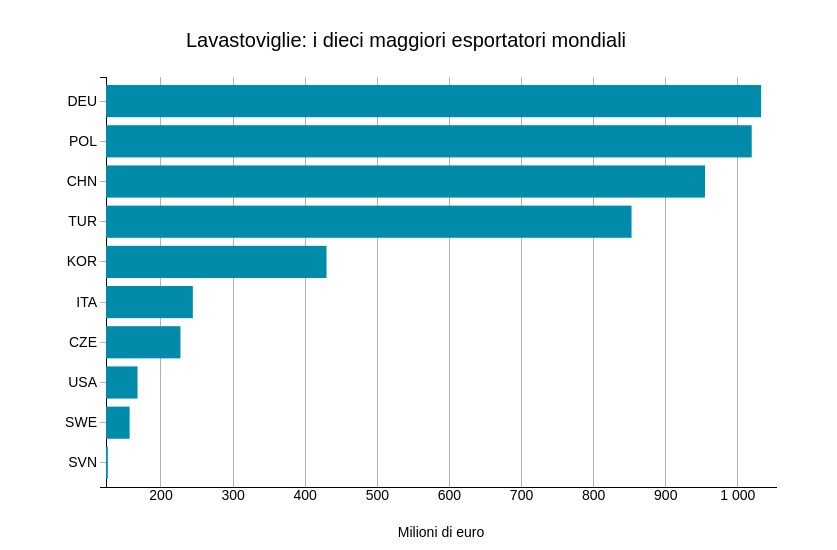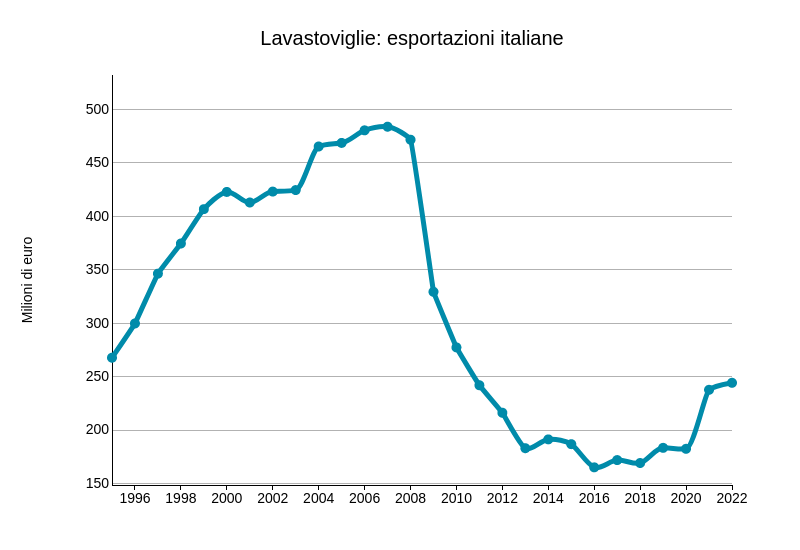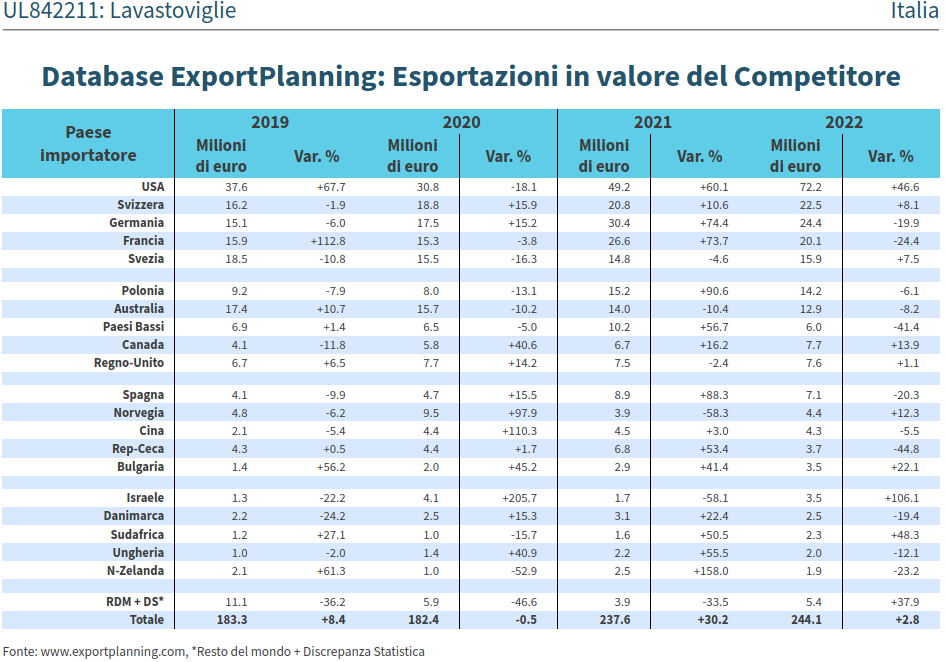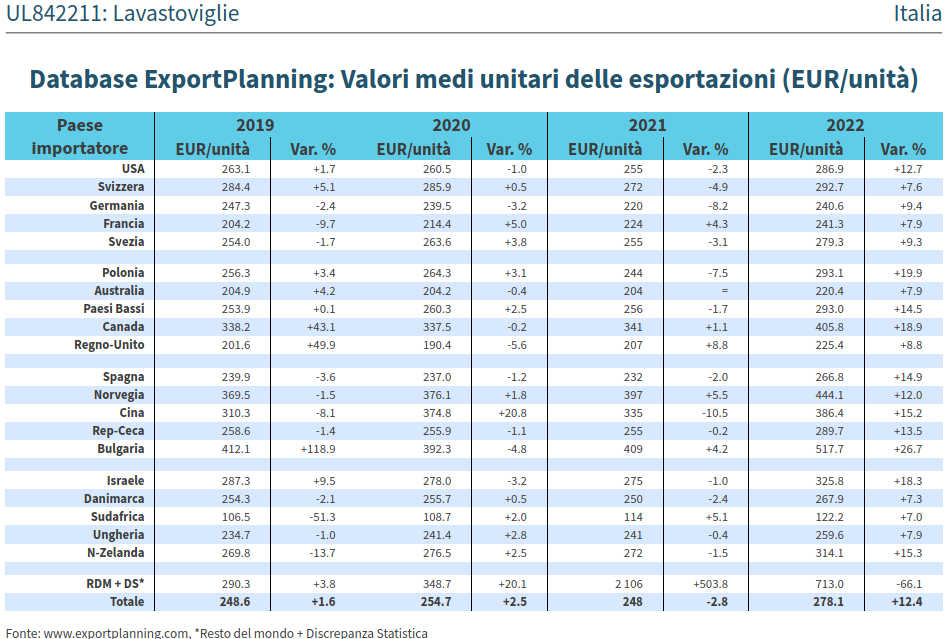Italy's exports of dishwashers
With the new release of the ExportPlanning competitor report, the tools for analyzing the export dynamics of a country of interest are enhanced
Published by Simone Zambelli. .
Internationalisation Foreign markets Foreign market analysis
Log in to use the pretty print function and embed function.
Aren't you signed up yet?
signup!
Within an internationalization process, one of the key steps is certainly to gain a deeper understanding of the main competitor countries, particularly by segmenting the major global exporters of the business area or product of interest.
This activity can be particularly useful in understanding which major markets are served by the competitor country and with which pricing strategies.
As already anticipated in the article "Market Analysis: the case of tiles in South Korea", ExportPlanning's Reporting tool is designed precisely to give support to this strategic activity, providing several report series aimed at effectively and efficiently analyzing a product, a target market and a competitor country.
For the purposes of example, in this article we will focus on the role of Italian exporters on the world stage of the dishwasher industry, segmenting the markets in which domestic firms are active and presenting the main new features introduced in the Statistical Appendix.
Italy on the world stage
With an export value of 244 million euros (2022), Italy ranks in the top 10 world exporters of dishwashers, but is at a level far below its neighboring competitor Germany, which opens the ranking of the world's largest players.

The result reflects the downsizing suffered by the Belpaese following the Great Recession, in the face of the difficulties experienced by the domestic home appliance industry. However, supported in part by the increase in international consumer interest in home products recorded in the aftermath of the pandemic, Italian exports ushered in a new season of growth in 2021-2022.

Before reviewing the different markets on which this growth has taken place over the past two years, it is important to point out the distinguishing feature of foreign trade data, namely the double declaration, made independently of each other. This means that the same flow is declared twice: the first time at the customs of the exporting country (as a flow in export), the second time at the customs of the importing country (as a flow in import).
Double declaration management and analysis in ExportPlanning
Given the nature of the double declaration of the same flow, as of today in ExportPlanning reports it will be possible to view both declarations within a dedicated Statistical Appendix, containing information from both the exporting country and the countries declaring imports from that partner country. In the case at hand, it is therefore possible to analyze both the figure declared by Italy for dishwasher exports and that speculatively declared by the main destination countries as the figure in imports from Italy of the product.
Fig. 1 – Italian exports of dishwashers

Fig. 2 – Italian exports of dishwashers: partner countries

The first of the two tables above presents the value data declared in exports from Italy, from where the goods departed, for the partner country of destination. The second table, on the other hand, presents the data in value declared by the importing countries from Italy. In general, these two data should coincide, but in practice, they very frequently have discrepancies, sometimes small and in some cases more significant, for a variety of reasons.
The discrepancies between the two statements may in fact be of various kinds:
- FOB and CIF values. Exports are reported gross of transportation and insurance costs to the border of the exporting country; imports also include transportation and insurance costs from the carrier's border to the importer's border;
- different months of departure and arrival. It is quite normal for goods transported by sea to leave in one month and arrive in a later month;
- errors due to the limitations of the customs administrative structure of different countries. Not all countries have a customs structure that can accurately detect inbound and outbound flows of goods;
- statistical segregation. If the number of reporting enterprises in a given month is less than 3, the data is generally segregated, that is, assigned to a higher customs code. Almost always, segregation occurs only on one side;
- Difference between country of departure and country of origin. In import declarations, the declared partner country is the country of origin, which may not be the country from which the goods arrived.
In the present case, for example, we see that the United States is the top destination market for Italian dishwasher exports, and it has been characterized by marked growth over the past two years. However, it is evident that there is some difference in the two statements of the same flow between the two countries.
Being two countries with a good customs structure, the main reason could be the difference due to the cost of transporting goods. Considerable discrepancies also open up for "neighboring" Germany, especially on 2021, probably due to delays in declarations. In contrast to the cases just listed, we find Switzerland, which is listed as the second destination country and whose declarations are perfectly aligned, both on the export and import side.
In order to limit distorting effects and to be able to extract the highest informative value from the available data, in ExportPlanning we consider a weighted average of the two declarations, where the weight is given by the country's degree of reliability in terms of customs administration.
The results of this processing are shown in the table below.
Fig. 3 – Italian exports of dishwashers: data from ExportPlannig

As the table shows, the data processed by ExportPlanning take into account both reported flows and make a weighted average of them. In addition, ExportPlanning data go through a series of specific checks designed to eliminate outliers and fill in any missing data. Finally, data for the latest available year are made available through sophisticated pre-estimation methods, based on the conjunctural declarations of the ExportPlannning sample of countries.
A final interesting insight is the analysis of average unit values to find out the dynamics followed by prices in recent years.
Fig. 4 – Italian exports of dishwashers: average unit values

As expected, in 2022, prices per unit of Italian dishwasher exports increased considerably to all major countries surveyed, registering, on average, an overall increase of more than 10%. The +12% recorded in the U.S. market and +19% in Poland and Canada jumps out at you.
Conclusions
Through the use of ExportPlanning reports, we can then perform an in-depth analysis on the competitor country, for the product/sector of interest. The enrichment that has taken place with the addition of the Statistical Appendix also makes it possible to compare the two exporting and importing country declarations of a given flow and clarifies the robust methods used by ExportPlanning to handle critical double declaration issues.


